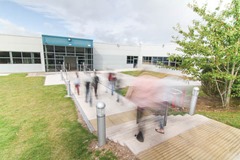Empowering times in transport
![Michael Fitzgerald, Abtran CEO[5] Michael Fitzgerald, Abtran CEO[5]](http://www.eolasmagazine.ie/wp-content/uploads/2014/09/MichaelFitzgeraldAbtranCEO5_thumb.jpg) Abtran CEO Michael Fitzgerald outlines how the customer is driving the delivery of service excellence in transport.
Abtran CEO Michael Fitzgerald outlines how the customer is driving the delivery of service excellence in transport.
The rapid penetration of mobile and digital technologies is setting new standards for the delivery of service across the public and private sectors.
Today’s customers are more empowered than ever before. They have become accustomed to a level of ‘always-on’ service connectivity.
They expect to have more control and prompt access to service information wherever and whenever they choose.
With digital engagement expected to grow rapidly, there is now an opportunity for both private and public sector organisations to deliver an even better, more efficient service experience by adopting a more collaborative and customer-centric approach.
Collaboration
The proliferation of digital technologies like geo-location based mobile apps, pay-as-you-go travel cards and electronic tolling has already led to more efficient and accessible services for the travelling public.
In the field of motor transport, the ability to access a growing number of online channels for application, registration and payment engenders more ownership on the part of the customer. Empowering customers to serve themselves also helps to drive increased data accuracy, higher levels of compliance, greater satisfaction and ultimately a safer driving experience for all.
In recent years, Abtran has seen greater collaboration and data-sharing across government departments. The future of service excellence in transport points to a more collaborative and joined-up approach, from identifying what is transferable and then building upon best practice and established centres of excellence.
 Identifying opportunities to leverage interoperability might include reusing existing infrastructure to establishing a single point of information capture and validation to consolidating access points and service channels.
Identifying opportunities to leverage interoperability might include reusing existing infrastructure to establishing a single point of information capture and validation to consolidating access points and service channels.
Not only does this reduce the cost to serve, improve return on investment and minimise roll-out times, it also results in a better, more consistent and superior service experience for the customer.
Collaborative ownership also lends itself to greater shared accountability. For instance, implementing governance structures and shared delivery models based on clear goals and performance measurement can lead to increased transparency and more streamlined efficiencies. Metrics and performance can further be benchmarked with national and international best practice.
A single view of the customer
With the advent of initiatives including real-time passenger information (RTPI), online journey planning and smart ticketing, today’s customers are enjoying unprecedented levels of access and control over their service journey.
For transport organisations in the public sector, collaborative principles of data-sharing and business intelligence could be extended to deliver a more joined-up customer journey experience. This might range from anticipating and pinpointing driver learning and/or testing requirements to licensing, motor tax renewal, NCT registration, journey planning and toll payment.
Further collaboration across analytics and business intelligence could therefore yield a more intuitive, predictive and personalised service experience to the customer based on their profile, service history and particular stage in the user journey.
For the collaborative customer – channel choice will remain key
Whilst the proliferation of self-service technology is enabling more autonomous customer behaviour, it will remain important to provide personal contact centre support via traditional voice channels, particularly for escalations and more complex service queries.
Mapping the end-to-end customer journey will remain central to designing a service experience that looks to deliver the right mix of channels with the right balance between contact centre, and self-service, web-based support.
 Whilst customer service via online channels like social media and web chat are continuing to gain traction, ‘crowd service’ looks set to grow with customers helping each other via peer-to-peer communities and online forums.
Whilst customer service via online channels like social media and web chat are continuing to gain traction, ‘crowd service’ looks set to grow with customers helping each other via peer-to-peer communities and online forums.
Putting the customer at the centre will remain core to the overall design and optimal delivery of service objectives. This will help to shape and inform service models, people skills, joined-up business processes, technology selection and overall service efficiency and performance measures.
Today’s citizens are living in an era of empowering times. Forward-looking organisations are already leveraging advances in data analytics and digital touch points to deliver a more personalised, intuitive and joined-up service experience.
To ensure Ireland’s leadership role in the future of service delivery, public sector organisations should look to a more collaborative, transferable and streamlined delivery model that yields clearer goals, greater efficiency and superior levels of customer service.
Service that is consistently designed around an understanding of the end-to-end customer journey will remain central to the continuous delivery of service excellence both now and into the future.
About Abtran
We serve citizens in regulated markets. Our focus is on making it easier for citizens to access services. We specialise in the delivery of Customer Engagement solutions (multichannel support, customer service, sales) and Identity-to-Entitlement services (licensing, registrations, grants processing, health administration, account opening, tolling). We provide flexible service solutions across a range of delivery models – insourced, fully outsourced, blended. We have proven capabilities across Government, Utilities and Financial Services.
Get in touch for more information on Abtran’s services.
 Tel: +353 (0)21 230 1800
Tel: +353 (0)21 230 1800
Email: info@abtran.com
Web: www.abtran.com
Twitter: @abtranglobal





